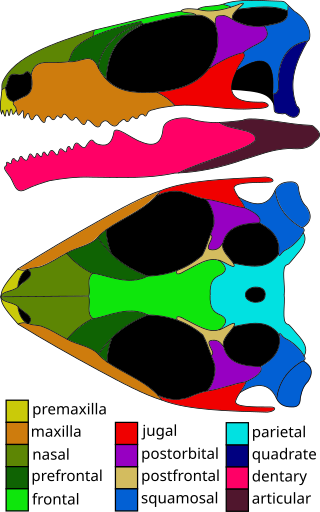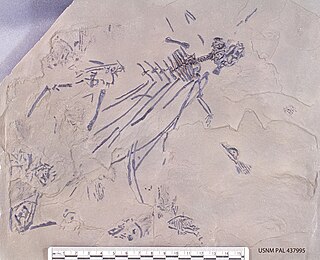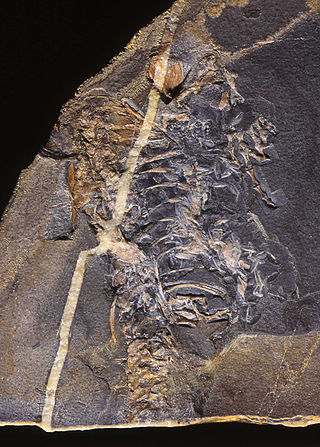
The tuatara is a species of reptile endemic to New Zealand. Despite its close resemblance to lizards, it is part of a distinct lineage, the order Rhynchocephalia. The name tuatara is derived from the Māori language and means "peaks on the back".

The Lepidosauria is a subclass or superorder of reptiles, containing the orders Squamata and Rhynchocephalia. Squamata includes lizards and snakes. Squamata contains over 9,000 species, making it by far the most species-rich and diverse order of non-avian reptiles in the present day. Rhynchocephalia was a formerly widespread and diverse group of reptiles in the Mesozoic Era. However, it is represented by only one living species: the tuatara, a superficially lizard-like reptile native to New Zealand.

Rhynchocephalia is an order of lizard-like reptiles that includes only one living species, the tuatara of New Zealand. Despite its current lack of diversity, during the Mesozoic rhynchocephalians were a speciose group with high morphological and ecological diversity. The oldest record of the group is dated to the Middle Triassic around 238 to 240 million years ago, and they had achieved global distribution by the Early Jurassic. Most rhynchocephalians belong to the group Sphenodontia ('wedge-teeth'). Their closest living relatives are lizards and snakes in the order Squamata, with the two orders being grouped together in the superorder Lepidosauria.

Sphenodontidae is a family within the reptile group Rhynchocephalia, comprising taxa most closely related to the living tuatara. Historically the taxa included within Sphenodontidae have varied greatly between analyses, and the group has lacked a formal definition. Cynosphenodon from the Jurassic of Mexico has consistently been recovered as a close relative of the tuatara in most analyses, with the clade containing the two and other very close relatives of the tuatara often called Sphenodontinae. The herbivorous Eilenodontinae, otherwise considered part of Opisthodontia, is considered to be part of this family in many recent studies as the sister group to Sphenodontinae. The earliest Sphenodontines are known from the Early Jurassic of North America, with other remains known from the Late Jurassic of Europe, the Late Cretaceous and possibly Paleocene of South America and the Miocene-recent of New Zealand. Sphenodontines are characterised by a complete lower temporal bar caused by the fusion of a forward directed process (extension) of the quadrate/quadratojugal and the jugal, which was an adaptation for reducing stress in the skull during hard biting. Other synapomorphies of Sphenodontinae include the presence of nasal foramina, a posterodorsal process of the coronoid of the lower jaw, the present of caniniform successional teeth at the front of the jaws, the presence of flanges on the posterior parts of teeth at back of the lower jaw, and an expanded radial condyle on the humerus. Like modern tuatara, members of Sphenodontinae were likely generalists with a carnivorous/insectivorous diet.

Elachistosuchus is an extinct genus of neodiapsid reptile, most likely basal archosauromorph, known from the Late Triassic Arnstadt Formation of Saxony-Anhalt, central Germany. It contains a single species, Elachistosuchus huenei, known from a single individual E. huenei, originally considered a pseudosuchian archosaur and then a rhynchocephalian lepidosaur, was largely ignored in the scientific literature, as its small size and fragility did not permit further mechanical preparation and examination. More recently however, a non-invasive μCT scanning was performed to resolve its placement within Reptilia, and found it to represent a more basal reptile, potentially closely related to several early archosauromorph clades.

Planocephalosaurus is an extinct genus of basal rhynchocephalian. Fossils of the genus are primarily known from fissure fill deposits from the Late Triassic of southwest Britain, with fragmentary remains possibly belonging to the genus also known from the Late Triassic of Texas.

Icarosaurus is an extinct genus of kuehneosaurid reptile from the Late Triassic Lower Lockatong Formation of New Jersey. It is closely related to lizards and the tuatara. Based on a partial skeleton missing part of the tail, some ribs, a hand, and parts of the legs, it was a small animal, about 10 centimeters (4 in) long from the skull to the hips. Like its relative Kuehneosaurus, it was able to glide short distances using 'wings' consisting of highly elongated ribs covered with skin. These gliding membranes would have had a convex upper surface and a concave lower surface, thus creating a simple airfoil structure well-suited to gliding. This method of gliding is also seen in Coelurosauravus and the modern Draco, neither of which are closely related to Icarosaurus.
Jason Castriota is an automotive designer.

Palaeohatteria is an extinct genus of basal sphenacodonts known from the Early Permian period of Saxony, Germany. It contains a single species, Palaeohatteria longicaudata.

The Māori people have had a strong and changing conservation ethic since their discovery and settlement of New Zealand. This is closely tied to their spiritual beliefs.

Cynosphenodon is an extinct genus of rhynchocephalian in the family Sphenodontidae from the Middle Jurassic La Boca Formation of Tamaulipas, Mexico. It is known from a largely complete lower jaw and fragments of the upper jaw. It is suggested to be among the closest known relatives of the tuatara, with both being placed in the Sphenodontinae, which is supported by among other characters, the growth pattern of the teeth.

Pamizinisaurus is a genus of sphenodontian reptile known from Lower Cretaceous (Albian) Tlayúa Formation of central Mexico. It was named Pamizinsaurus tlayuaensis by Reynoso in 1997, after Tlayua Quarry were it was found. It is known from the crushed skeleton of a juvenile individual, with a skull length of around 16 millimetres (0.63 in), and a total length of about 77 millimetres (3.0 in). The fossil was covered in small round osteoscutes, unique among known sphenodontians but similar to those of helodermatid lizards like the Gila monster, which probably served to protect it from predators.

Reptiles arose about 320 million years ago during the Carboniferous period. Reptiles, in the traditional sense of the term, are defined as animals that have scales or scutes, lay land-based hard-shelled eggs, and possess ectothermic metabolisms. So defined, the group is paraphyletic, excluding endothermic animals like birds that are descended from early traditionally-defined reptiles. A definition in accordance with phylogenetic nomenclature, which rejects paraphyletic groups, includes birds while excluding mammals and their synapsid ancestors. So defined, Reptilia is identical to Sauropsida.

Megachirella is an extinct genus of lepidosaur, possibly a stem-squamate that lived about 240 million years ago during the Middle Triassic and contains only one known species, Megachirella wachtleri. It is known from a partial skeleton discovered in the Dolomites of Northern Italy and was described in 2003.

Sphenotitan is an extinct genus of rhynchocephalian reptile, known from the Late Triassic (Norian) Quebrada del Barro Formation of Argentina. It is the earliest known member of the herbivorous Elienodontinae, and the only one known from the Triassic. It was a large-sized sphenodontian, with an estimated skull length of over 10 centimetres (3.9 in). The skull is roughly triangular in shape, and had large upper temporal fenestrae. The region of the skull in front of the eye socket is short. The premaxillae forms beak, with a cutting edge similar to a chisel. The teeth of Sphenotitan, like other elienodontines, were large and wide, and designed for shredding vegetation, with blade-like palatal teeth on the roof of the mouth.

Colobops is a genus of reptile from the Late Triassic of Connecticut. Only known from a tiny skull, this reptile has been interpreted to possess skull attachments for very strong jaw muscles. This may have given it a very strong bite, despite its small size. However, under some interpretations of the CT scan data, Colobops's bite force may not have been unusual compared to other reptiles. The generic name, Colobops, is a combination of κολοβός, meaning shortened, and ὤψ, meaning face. This translation, "shortened face", refers to its short and triangular skull. Colobops is known from a single species, Colobops noviportensis. The specific name, noviportensis, is a latinization of New Haven, the name of both the geological setting of its discovery as well as a nearby large city. The phylogenetic relations of Colobops are controversial. Its skull shares many features with those of the group Rhynchosauria, herbivorous archosauromorphs distantly related to crocodilians and dinosaurs. However, many of these features also resemble the skulls of the group Rhynchocephalia, an ancient order of reptiles including the modern tuatara, Sphenodon. Although rhynchosaurs and rhynchocephalians are not closely related and have many differences in the skeleton as a whole, their skulls are remarkably similar. As Colobops is only known from a skull, it is not certain which one of these groups it belonged to. Pritchard et al. (2018) interpreted it as a basal rhynchosaur, while Scheyer et al. (2020) reinterpreted it as a rhynchocephalian.
Fraxinisaura is an extinct genus of basal lepidosauromorph reptile known from the Middle Triassic of Germany. The only known species is Fraxinisaura rozynekae. It possessed an elongated snout, unique features of the teeth, and an ilium which was intermediate in orientation between sphenodontians and squamates. Based on characteristics of the maxilla, it is considered a close relative of Marmoretta from the Middle Jurassic of the United Kingdom, resolving a ghost lineage between that genus and other Triassic basal lepidosauromorphs.

Sphenofontis is an extinct genus of sphenodontian reptile known from the Late Jurassic of Germany, with a single known species, S. velserae. It is known from a single nearly complete and articulated sub-adult specimen, found in the late Kimmeridgian aged Torleite Formation in Brunn quarry in Bavaria, Southern Germany. It is thought to be a close relative of the living tuatara, tentatively referred to Sphenodontinae.
Tika is an extinct genus of sphenodontian from the Late Cretaceous Candeleros Formation of Argentina. The type species is Tika giacchinoi. It is considered to be closely related to the tuatara,, and a member of the Sphenodontinae. It is the oldest member of Sphenodontinae known from South America.
Saurosternon is an extinct genus of neodiapsid reptile from the Late Permian of South Africa. It is based on a partial skeleton split between two slabs of sandstone from the Daptocephalus Assemblage Zone. Saurosternon was one of the earliest small lizard-like reptiles to be discovered in Permian deposits of the Karoo Supergroup, preceding later discoveries such as Paliguana, Youngina, Palaeagama, and Lacertulus. The skeleton is mostly complete, though missing the head. Most of the original bone had decayed away by the time the fossil was discovered, leaving perfect molds in the sandstone slabs. What little bone remained was removed with acid by museum preparators, and the specimen was cast with latex to reconstruct the original bone shape.


















